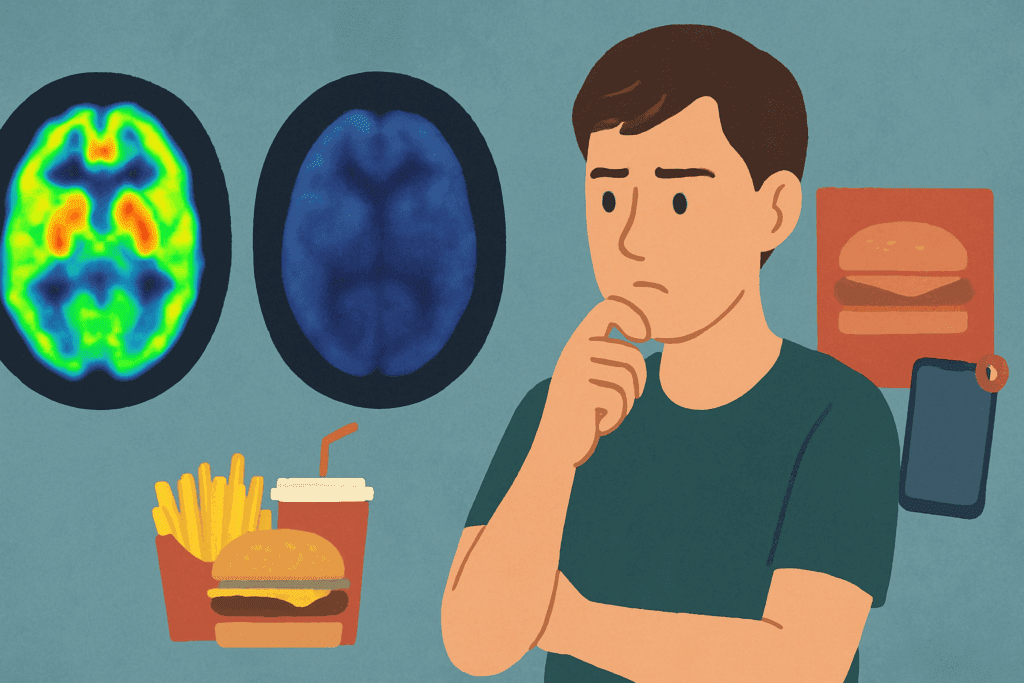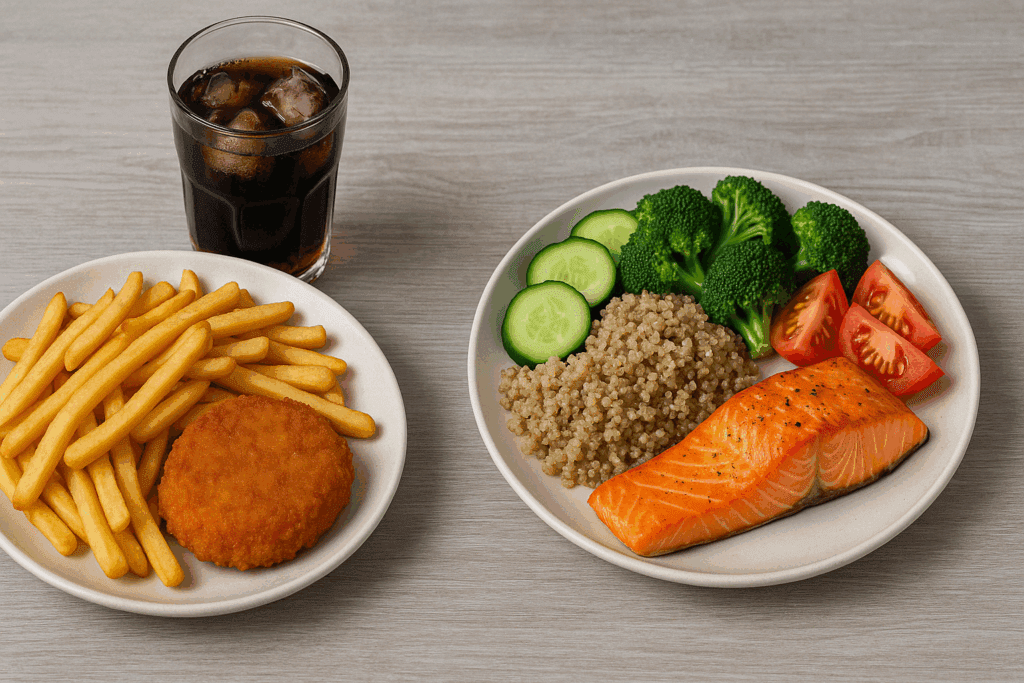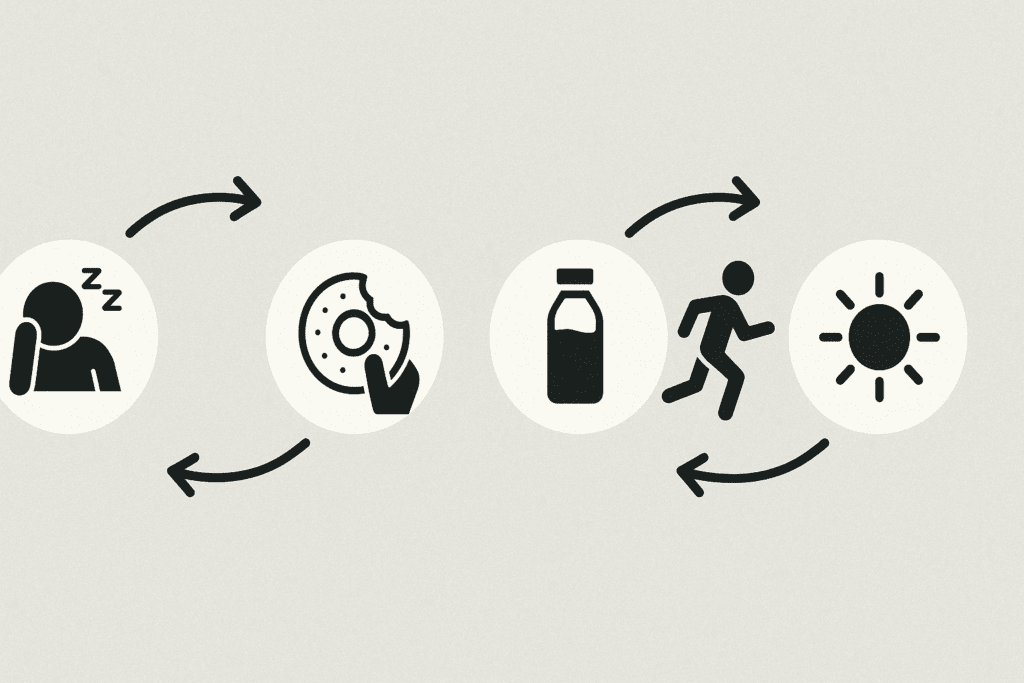In an age dominated by ultra-processed foods and fast-paced routines, breaking free from the grip of unhealthy eating can feel like an uphill battle. For many adults, especially those balancing careers, families, and academic commitments, understanding how to stop eating unhealthy food is both a health priority and a personal challenge. Poor dietary habits are not merely the result of weak willpower; they are shaped by psychological triggers, environmental cues, social norms, and biological feedback loops. This article explores comprehensive, evidence-backed strategies to help you stop eating bad food and replace it with nourishing choices that support long-term wellness.
You may also like: How to Stop Emotional Eating and Regain Control: Mindful Nutrition Strategies That Support a Healthier Lifestyle

Understanding Why We Crave Unhealthy Foods
To successfully transition away from poor dietary habits, we must first understand why unhealthy foods are so appealing. From a biological standpoint, high-sugar, high-fat foods trigger dopamine release in the brain, a chemical associated with pleasure and reward. Over time, repeated exposure to these foods conditions our brain to crave them, even in the absence of hunger. This reward cycle is particularly strong with “hyperpalatable” foods—those engineered to hit the perfect balance of fat, sugar, and salt.
Environmental factors further reinforce these cravings. Fast food chains are strategically placed near schools and offices, and snack foods dominate supermarket shelves. Social media, television commercials, and food delivery apps constantly bombard consumers with visual cues that activate cravings. Emotional triggers also play a significant role. Many individuals turn to food for comfort during stress, boredom, or sadness, reinforcing an emotional-eating loop that can become deeply ingrained.
To stop eating crap food, it’s essential to identify the cues that lead to these urges. Are you reaching for chips because you’re truly hungry or because you’re avoiding a task? Are late-night sugar cravings a response to emotional fatigue? By exploring the psychological and physiological roots of cravings, you empower yourself to break the cycle.

The Power of Nutrient-Dense Substitutions
Rather than attempting to eliminate unhealthy foods through sheer restriction, a more sustainable and effective strategy is to crowd them out with nourishing alternatives. Incorporating whole, nutrient-dense foods into your meals can gradually reduce your desire for ultra-processed snacks. For example, a lunch of grilled salmon with quinoa and roasted vegetables provides fiber, protein, and healthy fats that keep you satiated longer than a slice of pizza.
The key is to focus on balance rather than perfection. If you’re wondering how to stop eating bad food while maintaining a realistic routine, start by enhancing what’s already on your plate. Add a side of leafy greens to your usual meal. Replace sugar-laden granola bars with fruit and nut combinations. Experiment with herbs and spices to add flavor without relying on processed sauces.
Over time, your taste buds adapt. What once seemed bland may soon become delicious, while overly processed snacks can start to taste synthetic or overly sweet. Making mindful substitutions is not about deprivation—it’s about upgrading your meals to align with your wellness goals.
Habit Formation and the Science of Behavior Change
Understanding how habits form is crucial to replacing unhealthy ones with beneficial routines. According to behavioral science, every habit is built on a cue-routine-reward loop. The cue is the trigger that initiates behavior, the routine is the action taken, and the reward is the satisfaction gained from it. To stop eating unhealthy food, we must disrupt this loop and replace it with healthier alternatives.
For instance, if your cue is the mid-afternoon slump, and your routine is grabbing a sugary drink, consider substituting that drink with a glass of cold water infused with citrus and mint, followed by a brisk walk or a few minutes of stretching. This new routine still delivers the reward of refreshed energy but without the negative health consequences. Repeating this new pattern consistently rewires your brain and gradually turns the behavior into an automatic habit.
Consistency and patience are key. Research shows that it takes an average of 66 days to form a new habit, though this varies depending on complexity and individual differences. Utilize strategies such as habit stacking (linking a new behavior to an existing one), setting implementation intentions (“If I feel stressed, I’ll brew tea instead of eating chips”), and using reminders to build accountability. Through repetition and positive reinforcement, healthier habits become second nature.

Reframing the Language Around Food
Language has a profound impact on behavior and mindset. If you’re constantly telling yourself that you “can’t” have a certain food, it creates a sense of restriction and deprivation. This mindset often backfires, leading to binge episodes or feelings of guilt. Instead, reframing food choices through the lens of empowerment can help you stop eating crap food and feel good about it.
Consider shifting from phrases like “I’m not allowed to eat that” to “I’m choosing foods that support my health.” This subtle but powerful change repositions you as the active decision-maker rather than the victim of a rigid diet. It reinforces autonomy, which is a key driver of sustained behavior change.
Furthermore, avoid labeling foods as strictly “good” or “bad.” All foods exist on a spectrum of nutritional value, and occasional indulgences can be part of a balanced lifestyle. When you remove moral judgment from food, you reduce shame-based eating and create space for mindful, compassionate choices. A healthy relationship with food is built on understanding, not fear.

Mindful Eating and Emotional Awareness
One of the most effective ways to stop eating unhealthy food is by practicing mindful eating. This involves paying full attention to your food, savoring each bite, and listening to your body’s hunger and fullness cues. In a culture that often equates multitasking with productivity, meals are frequently consumed in front of screens or while distracted, which disconnects us from the eating experience.
Mindful eating reintroduces intention and pleasure into the act of nourishing your body. Begin by eliminating distractions during meals. Focus on the texture, flavor, and aroma of your food. Chew slowly and observe how your body responds. Are you eating out of hunger, habit, or emotion?
Recognizing emotional triggers is equally vital. Food can be a coping mechanism for managing difficult feelings. When you feel the urge to eat in response to stress, take a moment to pause. Journaling, deep breathing, or talking with a supportive friend can provide the emotional release you’re seeking—without resorting to unhealthy snacks. Over time, mindful awareness rewires your response to stress and supports more intentional choices.

Environmental Design and Digital Boundaries
Your physical and digital environments significantly influence what and how you eat. If you keep chips on the counter and sugary drinks in the fridge, you’re more likely to reach for them. Conversely, if fresh fruit is visible and pre-cut veggies are easy to grab, they become your default options. The principle of “choice architecture” suggests that the easier and more convenient a behavior is, the more likely you are to do it.
Reorganize your kitchen to make healthy choices visible and accessible. Place nutritious snacks at eye level, and store less healthy ones out of sight—or better yet, don’t buy them at all. Meal prepping can also reduce the likelihood of impulsive decisions. When healthy meals are ready in advance, the temptation to grab fast food on a busy evening diminishes.
Digital environments matter too. Unsubscribe from food delivery apps if they lead to impulsive ordering. Unfollow social media accounts that glamorize junk food. Instead, curate your feed with wellness content, cooking tutorials, and nutrition education. When you control the stimuli in your surroundings, you regain control over your behavior.
The Role of Social Support and Accountability
Behavior change is not a solo endeavor. Surrounding yourself with people who support your wellness goals can significantly impact your ability to stop eating bad food. Whether it’s a friend who shares healthy recipes, a co-worker who joins you for a morning smoothie, or a therapist who helps you unpack emotional eating patterns, social support enhances resilience and motivation.
Accountability also plays a crucial role. Sharing your intentions with others creates a sense of responsibility. You’re more likely to follow through when someone else is aware of your goals. This could mean texting a friend when you resist a craving, joining a nutrition-focused group, or working with a registered dietitian.
Importantly, the goal is not to achieve perfection but progress. Celebrate small wins along the way. Did you opt for a homemade lunch instead of ordering pizza? That’s a success. By acknowledging your efforts and receiving encouragement from others, you reinforce positive behaviors and create momentum for continued growth.
Understanding the Impact of Sleep and Stress on Food Choices
Sleep and stress are often overlooked factors in discussions about how to stop eating unhealthy food. Yet both exert profound influence over appetite regulation and decision-making. Sleep deprivation disrupts the balance of ghrelin and leptin—hormones that signal hunger and fullness. When you’re sleep-deprived, your body craves high-calorie, sugary foods as a quick source of energy.
Chronic stress activates the hypothalamic-pituitary-adrenal (HPA) axis, leading to elevated cortisol levels. This not only increases appetite but also shifts preference toward comfort foods. Managing stress through regular exercise, meditation, and time in nature can mitigate these effects and reduce emotional eating episodes.
Prioritizing restorative sleep is equally important. Create a consistent bedtime routine, minimize blue light exposure in the evening, and ensure your sleep environment is cool and dark. As your sleep quality improves, so will your capacity to make rational, health-promoting food choices.
Building Sustainable Meal Patterns That Satisfy
Many people fall into the trap of restrictive dieting, only to swing to the opposite extreme when deprivation becomes unbearable. Instead of focusing on what you “can’t” eat, focus on creating meals that are satisfying, balanced, and enjoyable. A sustainable eating pattern includes carbohydrates, fats, and proteins in proportions that align with your body’s needs and energy demands.
Meal planning can be a powerful tool. By mapping out your meals in advance, you reduce the likelihood of last-minute decisions that often lead to fast food or convenience store snacks. Planning doesn’t have to be rigid. Flexibility and variety keep things interesting while ensuring nutritional adequacy.
Include a range of textures and flavors to make meals enjoyable. Think of a hearty lentil stew with crusty whole-grain bread or a colorful stir-fry with tofu, broccoli, and a drizzle of sesame oil. When your meals are both nutritious and pleasurable, you’re far less tempted by less healthful alternatives. In this way, you stop eating crap food not by force, but by preference.

Resilience, Relapse, and the Journey Toward Food Freedom
Despite best efforts, setbacks are inevitable. You may eat more than you intended at a celebration or find yourself stress-eating after a difficult week. Rather than viewing these moments as failures, it’s crucial to see them as part of the learning process. What triggered the behavior? What can you do differently next time?
Developing resilience means staying committed to your health goals even when progress isn’t linear. Reflect on your motivations and revisit your “why.” Maybe you want more energy for your children or to reduce your risk of chronic disease. When setbacks occur, respond with compassion rather than criticism. Self-compassion reduces shame and increases the likelihood of returning to positive behaviors.
The journey to stop eating unhealthy food is a long-term endeavor, not a quick fix. It requires experimentation, curiosity, and persistence. But with the right tools and mindset, it is entirely achievable. Every positive choice reinforces your identity as someone who values health and well-being.
Frequently Asked Questions: How to Stop Eating Unhealthy Food
1. What’s one often-overlooked reason people keep eating unhealthy food even when they want to stop? One overlooked reason people struggle with how to stop eating bad food is that they lack a strong, intrinsic motivation tied to personal values. While many focus on external motivators like weight loss or doctor recommendations, these often lose power over time. By contrast, aligning food choices with core values—such as being an energetic parent or setting a good example for children—creates deeper emotional engagement. When individuals connect dietary changes to identity and purpose, they’re more likely to persist. Reframing health goals this way offers a sustainable path for those wondering how to stop eating unhealthy food long-term.
2. How does sensory adaptation play a role in food cravings and unhealthy eating? Sensory adaptation refers to the process by which our taste buds become desensitized to flavor intensity. When people consistently eat heavily processed, high-sodium, and high-sugar foods, their palate adjusts to expect these levels of stimulation. This makes nutrient-dense foods like vegetables or legumes seem bland by comparison. For those figuring out how to stop eating crap food, a helpful approach is to gradually reduce added sugars and processed seasonings while reintroducing fresh herbs, spices, and natural ingredients. Over time, taste sensitivity recalibrates, making whole foods more appealing without feeling like a sacrifice.
3. Can gut health impact cravings for unhealthy food? Yes, emerging research shows a clear link between gut microbiota and dietary preferences. Certain gut bacteria thrive on sugar and refined carbs and may influence neural pathways to increase cravings for those very foods. This microbial manipulation can subtly undermine your efforts to stop eating unhealthy food by intensifying your desire for it. Incorporating prebiotic and probiotic foods, such as yogurt, kefir, fermented vegetables, and fiber-rich fruits, can shift the microbiome composition. Doing so supports a healthier internal environment, potentially reducing the subconscious pull toward junk food.
4. What role does decision fatigue play in poor eating choices? Decision fatigue occurs when the mental effort required to make repeated choices leads to diminished self-control. By the end of a demanding day, many people default to whatever food is most convenient or comforting. This is especially problematic when trying to figure out how to stop eating crap food. One powerful solution is to automate decisions in advance. For instance, meal prepping or rotating go-to healthy recipes can reduce the number of decisions you need to make, conserving willpower and supporting better food choices without relying on moment-to-moment discipline.
5. How can you break the cycle of late-night snacking on junk food? Late-night cravings often stem from emotional triggers, unregulated stress, or even unstructured eating earlier in the day. Instead of focusing only on resisting the urge, it’s important to look at why the habit exists in the first place. Improving sleep hygiene, managing stress throughout the day, and ensuring your evening meal includes sufficient protein and fiber can help stabilize blood sugar and reduce post-dinner cravings. Developing a wind-down routine that involves non-food rewards—like journaling, reading, or herbal tea—can redirect habitual behaviors. Understanding how to stop eating bad food at night begins with anticipating patterns and replacing them with intentional, calming rituals.
6. Is there a connection between screen time and poor eating habits? There is growing evidence that excessive screen time is linked to poor dietary patterns. The more time spent on digital devices—especially while eating—the less attuned individuals are to hunger and fullness signals. Additionally, scrolling through food-centric content can stimulate cravings for hyperpalatable options. If you’re working on how to stop eating unhealthy food, setting digital boundaries can be a strategic move. Try implementing screen-free meals and limiting exposure to tempting food content online to foster more mindful eating behaviors and reduce impulsive snacking.
7. Are there personality traits linked to struggles with unhealthy eating? Certain personality traits, like impulsivity and low conscientiousness, are associated with a higher likelihood of unhealthy eating. While these traits don’t doom anyone to poor habits, they may require customized strategies. For example, people who are highly impulsive may benefit more from environmental controls, such as not keeping junk food at home, while those low in conscientiousness might do better with structured meal plans and reminders. Recognizing your own tendencies is key in developing a personalized plan for how to stop eating crap food effectively and compassionately.
8. How do cultural and social environments influence our eating habits? Cultural norms and social circles have a profound impact on what and how we eat. Shared traditions, peer behaviors, and communal expectations can normalize unhealthy choices or make it difficult to resist social pressure. For instance, declining dessert at a family gathering may be interpreted as rude in some cultures. For anyone committed to learning how to stop eating bad food, it helps to develop strategies for navigating social situations without compromising values. This might include bringing a healthy dish to share or preparing a polite response to food offers that don’t align with your goals.
9. What are some unexpected benefits of reducing unhealthy food intake? While the common benefits of healthier eating—like weight loss or better energy—are well-known, there are also more subtle rewards. Many people report improved focus, clearer skin, better digestion, and even enhanced emotional regulation. Reducing reliance on sugar and processed ingredients stabilizes mood swings and supports mental clarity. These lesser-known perks can serve as powerful motivators for those exploring how to stop eating unhealthy food—not just for physical health, but for overall quality of life. When the mind feels more balanced and the body functions optimally, motivation for sustaining positive habits grows stronger.
10. What’s the long-term outlook for someone trying to break free from unhealthy eating patterns? The journey toward healthier eating is dynamic, and progress rarely follows a straight line. Relapses are common but don’t negate success. What matters most is the ability to bounce back with greater insight each time. Over months and years, the skills developed—such as emotional regulation, strategic planning, and self-awareness—extend beyond food and influence broader life satisfaction. For those wondering how to stop eating bad food in a lasting way, it’s encouraging to know that the brain and body are adaptable. With consistent effort and the right support, unhealthy food can lose its hold, allowing room for a nourishing, empowered way of living.
Conclusion: Reclaiming Your Health by Breaking Free from Unhealthy Food Habits
Learning how to stop eating unhealthy food is about much more than avoiding chips or skipping dessert. It’s about reclaiming your autonomy, nourishing your body, and creating a lifestyle rooted in intention rather than impulse. By understanding the psychological, environmental, and biological factors that drive your choices, you gain the power to change them. Through mindful eating, nutrient-dense meals, consistent habits, and compassionate self-reflection, you can stop eating bad food and embrace a lifestyle that supports vitality and joy.
The process of transformation is rarely linear. It demands resilience, patience, and a willingness to experiment with what works for you. But as you shift your relationship with food, you also shift your relationship with yourself—toward one of care, respect, and empowerment. Let this be your reminder that real change doesn’t come from restriction, but from connection—to your body, your values, and the life you truly want to lead.
Was this article helpful? Don’t let it stop with you. Share it right now with someone who needs to see it—whether it’s a friend, a colleague, or your whole network. And if staying ahead on this topic matters to you, subscribe to this publication for the most up-to-date information. You’ll get the latest insights delivered straight to you—no searching, no missing out.
Further Reading:
6 Steps to Changing Bad Eating Habits
How to Stop Eating Junk Food: 10 Tips to Control Your Cravings

